
A Carnegie library is a library built with money donated by Scottish-American businessman and philanthropist Andrew Carnegie. A total of 2,509 Carnegie libraries were built between 1883 and 1929, including some belonging to public and university library systems. 1,689 were built in the United States, 660 in the United Kingdom and Ireland, 125 in Canada, and others in Australia, South Africa, New Zealand, Serbia, Belgium, France, the Caribbean, Mauritius, Malaysia, and Fiji.

The Carnegie Library of Pittsburgh is the public library system in Pittsburgh, Pennsylvania. Its main branch is located in the Oakland neighborhood of Pittsburgh, and it has 19 branch locations throughout the city. Like hundreds of other Carnegie libraries, the construction of the main library, which opened in 1895, and several neighborhood branches, was funded by industrialist Andrew Carnegie. The Pittsburgh area houses the first branches in the United States.

Carnegie Museums of Pittsburgh are four museums that are operated by the Carnegie Institute headquartered in the Carnegie Institute complex in the Oakland neighborhood of Pittsburgh, Pennsylvania. The Carnegie Institute complex, which includes the original museum, recital hall, and library, was added to the National Register of Historic Places on March 30, 1979.

Lawrenceville is one of the largest neighborhood areas in Pittsburgh in the U.S. state of Pennsylvania. It is located northeast of downtown, and like many of the city's riverfront neighborhoods, it has an industrial past. The city considers Lawrenceville three neighborhoods, Upper Lawrenceville, Central Lawrenceville, and Lower Lawrenceville, but these distinctions have little practical effect. Accordingly, Lawrenceville is almost universally treated as being a single large neighborhood.
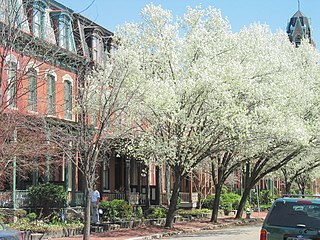
Manchester is a North Shore neighborhood in Pittsburgh, Pennsylvania. The neighborhood is represented on Pittsburgh City Council by the District 6. Manchester houses PBF Battalion 1 & 37 Engine, and is covered by PBP Zone 1 and the Bureau of EMS Medic 4. The neighborhood includes the Manchester Historic District, which protects, to some degree, 609 buildings over a 51.6-acre (20.9 ha) area. The district was listed on the National Register of Historic Places in 1975. It uses ZIP code of 15233.

The Carnegie Library of Homestead is a public library founded by Andrew Carnegie in 1898.
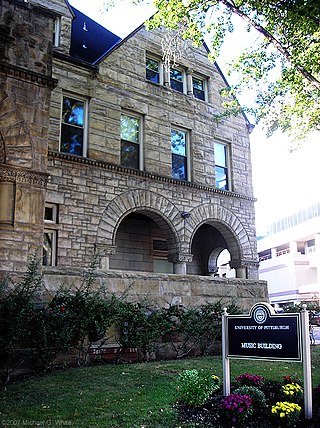
Longfellow, Alden & Harlow, of Boston, Massachusetts, and Pittsburgh, Pennsylvania, was the architectural firm of Alexander Wadsworth Longfellow Jr. (1854–1934), Frank Ellis Alden (1859–1908), and Alfred Branch Harlow (1857–1927). The firm, successors to H. H. Richardson, continued to provide structures in the Romanesque revival style established by Richardson that is often referred to as Richardsonian Romanesque.

The Braddock Carnegie Library in Braddock, Pennsylvania, is the first Carnegie Library in the United States. As such, the library was named a National Historic Landmark in 2012, following its listing on the National Register of Historic Places in 1973, and is on the Pittsburgh History and Landmarks Foundation's List of Historic Landmarks.

The Arsenal Middle School in the Lower Lawrenceville neighborhood of Pittsburgh, Pennsylvania, was built in 1932, with a wing for elementary students added in 1939. The school was listed on the National Register of Historic Places in 1986.

The Carnegie Free Library of Allegheny is situated in the Allegheny Center neighborhood of Pittsburgh, Pennsylvania. It was commissioned in 1886, the first Carnegie library to be commissioned in the United States. Donated to the public by entrepreneur Andrew Carnegie, it was built from 1886 to 1890 on a design by John L. Smithmeyer and Paul J. Pelz.
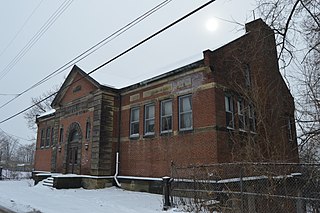
The Hazelwood Branch of the Carnegie Library of Pittsburgh located at 4748 Monongahela Street in the Hazelwood neighborhood of Pittsburgh, Pennsylvania, was built in 1899. It was added to the List of City of Pittsburgh historic designations on July 28, 2004.
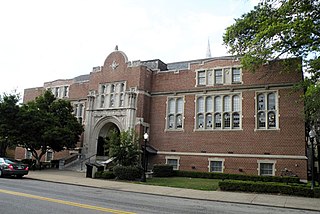
The Homewood Branch of the Carnegie Library of Pittsburgh is a library in Pittsburgh, Pennsylvania. It is located at 7101 Hamilton Avenue in the Homewood South neighborhood and opened on March 10, 1910. It was designed by the architectural firm Alden & Harlow, and it was added to the List of City of Pittsburgh historic designations on July 28, 2004, and the List of Pittsburgh History and Landmarks Foundation Historic Landmarks in 2004. This library was featured in an episode of Mister Rogers' Neighborhood.
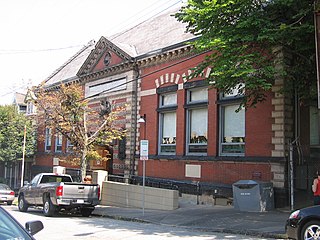
The Lawrenceville Branch of the Carnegie Library of Pittsburgh, located at 279 Fisk Street in the Lawrenceville neighborhood of Pittsburgh, Pennsylvania, opened May 10, 1898. It was originally commissioned as part of Andrew Carnegie's first grant to Pittsburgh and was the second library in the Pittsburgh city system to open, following the Main Branch.

The Mount Washington Branch of the Carnegie Library of Pittsburgh located at 315 Grandview Avenue in the Mount Washington neighborhood of Pittsburgh, Pennsylvania, was built in 1900. It was designed by the architectural firm Alden & Harlow, and it was added to the List of City of Pittsburgh historic designations on July 28, 2004 and the List of Pittsburgh History and Landmarks Foundation Historic Landmarks in 1989.

The Old Stone Tavern is a historic building located at 434 Greentree Road, block and number 19-S-156, in the West End Village neighborhood of Pittsburgh, Pennsylvania. The Tavern dates back to at least 1782, and more likely 1777.
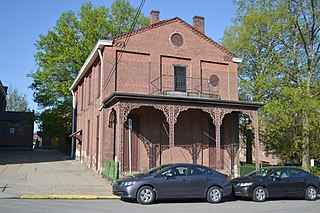
The Saint Mary's Academy Building is a historic building in the Lawrenceville neighborhood of Pittsburgh, Pennsylvania. Built in 1854, it is a notable example of Greek Revival architecture and one of the neighborhood's only surviving buildings dating to the pre-Civil War era. It was the first structure built by St. Mary's parish, the first Catholic parish in Lawrenceville, and was originally used as both a church and school. In 1874, a new St. Mary's Church was built next door. St. Mary's merged with three other Lawrenceville parishes in 1993 to form the new Our Lady of Angels parish. The St. Mary church buildings remained in use for a few years but closed in 2004.
The following is a timeline of the history of the city of Pittsburgh, Pennsylvania, US.
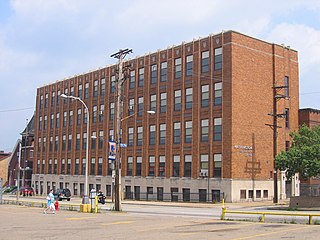
Washington Education Center is a former vocational school in the Pittsburgh neighborhood of Lawrenceville at 40th Street and Eden Way.
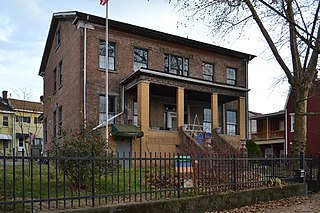
The Mowry-Addison Mansion is a historic house in the Upper Lawrenceville neighborhood of Pittsburgh, Pennsylvania, and a contributing property in the Lawrenceville Historic District. It was built in 1830–32 by Peter Mowry, a physician, and was originally part of a large estate that was subdivided into residential lots in 1872. The house is notable as a rare example of relatively well preserved Greek Revival architecture in Pittsburgh, and exemplifies the typical pattern of development in Lawrenceville in the mid to late 19th century. In 2020, the building was nominated as a Pittsburgh historic landmark by Preservation Pittsburgh, which stated that the mansion "is one of the last remaining and most significantly preserved regional ribbon farm dwellings from its period of construction."




















